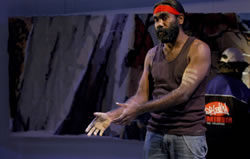MIAF: Ngapartji Ngapartji, La Fille de Cirque
Festival Dairy #2
Keen observers might notice that TN is wilting a little. I'm not complaining - far from it - but I'm thinking rather wistfully of the long-departed elasticity of youth, when I could party all night and work all day and still keep going (four days was the limit, as I recall, before I collapsed into brutish slumber). However, before anyone starts spitting on me for whingeing about my privileged existence, I will gracefully segue into What Little Alison Saw At MIAF Last Week.
Ngapartji Ngapartji (I give you something, you give me something). Key performer/co-creator Trevor Jamieson, writer/director Scott Rankin. Design by Genevieve Dugard, lighting design by Neil Simpson, choreography by Yumi Umiumare. With Pantjiti McKenzie, Jennifer Mitchell, Lorna Wilson, Iris Ajax, Nami Kulyuru, Rhoda Tjitayi, Dora Haggie, Elton Wirri, Julie Miller, Sadie Richards, Nathaniel Garrawurra, Mervin Adamson, Yumi Umiumare, Lex Marinos, Najeeba Azimi, Saira Luther, Damian Mason, Andrew McGregor. Big hART @ the Fairfax Studio, Victorian Arts Centre
In the 1950s, when the Cold War was at its chilliest, the British Government asked permission from the Prime Minister Robert Menzies to perform nuclear tests on Australian soil. Menzies more or less said, go for it, boys! And subsequently nuclear bombs were dropped on a variety of sites in northern and southern Australia, most notably at Maralinga.
In a continuation of the de facto policy of Terra Nullius, nobody asked the permission of the traditional owners of the land. Thousands of Indigenous people were forcibly removed and placed in refugee camps, and an unknown number were never found by the Aboriginal Protectors and died on their lands. The tests spread radioactive clouds as far as Adelaide, but there are no records of their impact on the area's inhabitants: back then, Indigenous people were not counted in the Census or in medical records. Notoriously, signs warning people to keep off the polluted country were posted in English. Trevor Jamieson, the charismatic performer at the centre of this show, is from Spinifex country in the Western desert, the supposedly waste lands on which these bombs were tested, and Ngapartji Ngapartji is, among other things, the story of his family and how they lost their traditional lands in the most violent and irretrievable way imaginable. It's yet another story of the dispossession of colonisation, this time with a nuclear twist. But this show is much more than an enactment of that loss.
Trevor Jamieson, the charismatic performer at the centre of this show, is from Spinifex country in the Western desert, the supposedly waste lands on which these bombs were tested, and Ngapartji Ngapartji is, among other things, the story of his family and how they lost their traditional lands in the most violent and irretrievable way imaginable. It's yet another story of the dispossession of colonisation, this time with a nuclear twist. But this show is much more than an enactment of that loss.
Ngapartji Ngapartji means, "I give you something, you give me something", a literalisation of what is always an implicit exchange in the act of theatre. As soon as you see that the stage, which is covered with black sand, is actually a dancing ring, it becomes clear that this is theatre that calls on its ritual roots. You are not buying a ticket to a show: you are being invited to participate in a ceremony.
Big hArt is a community theatre company that works with marginalised people in small communities around Australia on long term projects which are then taken to national and international arts festivals. Like communities themselves, it is fluid and multiple: Ngapartji Ngapartji is only one of seven projects it is currently running around the country. This piece of theatre is itself part of a larger work that includes an online site that teaches Pitjantjatjara and is a focus for weekly meetings between young people and elders of various communities in the Northern Territory and South Australia.
The show begins with introductions: you meet Trevor and his sister and his Mum, and all the members of the cast, including the Pitjantjatjara Choir, and are taught a few words of Pitjantjatjara with a children's song. Tried and true audience participation, Wiggles style, but curiously unembarrassing, perhaps because it is so transparently friendly. It is, in the way of these things, faintly shambolic, but switches rapidly to honed, riveting performance, an oscillation that continues through the show.
Trevor Jamieson and writer/director Scott Rankin incorporate Western, Indigenous and Asian theatre traditions to create what is almost utopian enactment of cross-cultural understanding. The story of the dispossessed desert peoples is interspersed with other narratives of exile: the Japanese mother who was caught in the blast at Hiroshima, the Middle Eastern mother fleeing her country with her daughters, trying desperately to reach her husband in Australia. One remarkable aspect of this work is that it is never narrow or accusatory in its focus. Jamieson remembers, for instance, that when the bones of dead children were taken without their parents' permission and ground up by medical authorities to test their levels of radioactivity, they were from both white and black families.
The stories are told through a mixture of shadow puppetry, straight narration, dance, song (including a Talking Heads song in Pitjantjatjara) and movement. It's a moving and involving work that authentically achieves what it sets out to do. It is at once a lament for the dead, a joyous celebration of survival and an extraordinary expression of reconciliation. This kind of theatre is often done badly, relying on the goodwill and sympathy of an audience to get it through the shaky bits. Ngapartji Ngapartji miraculously avoids any such trying of patience: what could easily be sentimentality or just plain dagginess becomes, instead, a pure gift.
La Fille de Cirque, Camille, Hamer Hall, Victorian Arts Centre
Like many Melburnians, I last saw Camille in the intimate space of the Speigeltent as part of the hit burlesque La Clique. So I was curious to see how this creature of delicate raunch would go in the far less intimate Hamer Hall - would she be lost in the vastness of it all?
Not a chance. She filled it up, and then some. The ghost of cabaret clings to the act, all the same: some privileged audience members were on stage, drinking at candlelit tables, and Camille wandered off into the stalls more than once to pour herself seductively into the lap of some embarrassedly delighted man. Camille is the real thing, make no mistake. Like Tom Waits, her show is sheer theatre. Ably backed by her sharp six-piece band, she doesn't sing songs, she performs them: that enchanting voice is put wholly at the service of expressiveness, dropping to a whisper or opening to a full-throated rock and roll roar. She sashays through a repertoire of songs by Jacques Brel, Nick Cave and Tom Waits, invoking the tenderness of old lovers, the brutal business of a whorehouse in Amsterdam, the thoughts of a condemned man. Her lack of inhibition makes her spell-bindingly sexy: she is not afraid of crawling on the ground, or of transforming into a grotesque and angry clown.
Camille is the real thing, make no mistake. Like Tom Waits, her show is sheer theatre. Ably backed by her sharp six-piece band, she doesn't sing songs, she performs them: that enchanting voice is put wholly at the service of expressiveness, dropping to a whisper or opening to a full-throated rock and roll roar. She sashays through a repertoire of songs by Jacques Brel, Nick Cave and Tom Waits, invoking the tenderness of old lovers, the brutal business of a whorehouse in Amsterdam, the thoughts of a condemned man. Her lack of inhibition makes her spell-bindingly sexy: she is not afraid of crawling on the ground, or of transforming into a grotesque and angry clown.
Anyone looking for flawless museum renditions of French torch songs is going to be very disappointed. Part of what is riveting about this show is the immediacy Camille generates on stage; she is passionate, abject, tender, with a bracing tang of bitter irony. She drinks constantly, at one point knocking over a bottle of wine. It's all artifice, but it's also not artifice at all: there is a dangerous edge of the real underneath everything she does, a sense that anything at all might happen, including the chanteuse being carried out on a stretcher. It's a quality common to singers like Janis Joplin, Nina Simone, Edith Piaf or Patti Smith; like these stars, Camille soars beyond virtuosity into the imperfection of true greatness.








No comments:
Post a Comment